Cracking India’s Funding Code:Where to Begin and What to Know
November 5, 2024

Getting funding for your startup can be a make-or-break moment. In India, the funding landscape is a unique mix of “desi jugaad” and traditional financial paths, with options that range from bootstrapping to angel investors and government grants. Here’s a no-nonsense guide to help you navigate the funding journey.
1. Start Small with Bootstrapping
Many successful Indian startups started out by bootstrapping, funding their venture with personal savings or small contributions from friends and family. Bootstrapping offers independence but requires careful budgeting. If you believe in your product, bootstrapping is a good first step that also shows investors you’re serious and resourceful.
2. Angel Investors: Finding the Right “Godfather”
Angel investors are high-net-worth individuals who fund startups in their early stages. They’re like the “godfathers” of your business, providing not only money but also valuable mentorship. Platforms like Indian Angel Network and Mumbai Angels connect startups with investors who are open to taking a risk for potentially high returns. The key? Pitch with clarity, enthusiasm, and data to show them the value of your venture.
3. Venture Capital: Scaling with Big Bucks
If you’ve validated your idea and need serious funding to scale, venture capital (VC) is the next step. VCs bring in substantial funds and open doors to extensive networks, but they also expect rapid growth and a clear return on investment. Leading VC firms like Sequoia Capital India and Accel focus on tech, healthcare, and fintech startups. Before approaching them, have a solid business model, a clear revenue stream, and data-backed growth projections.
4. Government Schemes: Leveraging Sarkari Support
The Indian government is big on supporting startups, with schemes like Startup India, Stand-Up India, and Mudra Yojana offering loans, grants, and mentorship for eligible startups. These programs are particularly beneficial for first-time entrepreneurs, small businesses, and women-led startups. Make sure to research eligibility criteria, as these schemes can be instrumental in setting up without giving away equity.
5. Crowdfunding: Testing the Waters with the People
Crowdfunding is gaining popularity in India and is perfect for innovative ideas with mass appeal. Platforms like Ketto and Fueladream allow you to pitch your idea directly to the public, who can contribute small amounts. This approach not only raises funds but also validates your idea in the market. Remember, the key to successful crowdfunding is a compelling story and an effective marketing strategy.
6. Strategic Partnerships: Growth Beyond Cash
Not all support comes in cash. Strategic partnerships can bring in-kind benefits like resources, technology, and market reach, helping you scale without high costs. For instance, partnerships with tech platforms can provide software or cloud credits, while alliances with established firms can expand your distribution channels. These collaborations are especially useful for tech and service-based startups.
Wrapping Up: “Paisa” is Just the Start!
Finding the right funding is crucial, but remember, “paisa” (money) is just the start of your journey. Investors look for commitment, a solid plan, and a scalable business model. Be transparent, build trust, and keep hustling to turn your funding into growth.
Stay tuned with https://rojpe.com for more such fresh and amazing perspective about finance and startup in India!
